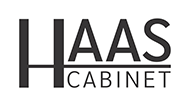
Haas Kitchen and Bath cabinets are finished using the latest technology ultra-violet cured or conversion varnish clear finishes. As such, they should not need to be waxed or polished to maintain their beauty. However, an occasional waxing (once or twice a year) using a silicone free cleaner/polish made for wooden products will not harm your cabinets. Your kitchen cabinets will look great for a long time if they are kept clean. Assuming your kitchen gets normal use, you will find that cabinets around the range, dishwasher, sink, and other highly used areas will need to be cleaned on a regular (6 to 10 times a year) basis. Cabinets around a cooking surface will tend to pick up a lot of greasy residue. This residue is probably easier to feel than to see. Cabinets around a sink or waste basket will get water spots and possibly some food residue which should be cleaned often to avoid long term damage to the cabinet’s finish.
Cleaning your wooden cabinets is not difficult as long as you keep the cabinet finish in good shape. Problems can develop if an excessive amount of water is used to clean a cabinet with a cracked or damaged finish. This water will eventually soak into the wood fibers of the cabinet and can cause finish failure in spots. Just be sure to exercise caution and completely dry the products when cleaning around finish cracks (most often associated with painted products near joints).
The best method to clean the cabinet is to use a soft cloth and a mild soap mixture diluted with water (2 cups water to 2 teaspoons soap). Dawn and Ivory dish soaps do a good job of cutting grease. Diluted Murphy’s Oil Soap is another very good wood cleaner as it is made with oil and lye that combine to produce a mild soap when worked onto the surface. Orange-Glo is another good cleaning solution. Absolutely avoid using cleaners that contain ammonia as this chemical can cloud the finish in some cases.
Keep the cabinets dry. Mopping on huge amounts of water and letting the water dry on the surface is definitely a no-no. It is a wood product underneath that pretty finish and wood and water have had their differences since the beginning of time. Whatever you do, make sure the cabinets are dried when you are finished cleaning them.
Use a soft cloth. Using a cloth that is not soft is the same as taking a piece of sandpaper to your finished surface. Your cabinet finish is very hard, but years of scrubbing on them with anything even mildly abrasive will eventually diminish even the toughest finish.
Never, ever use a cleaning solution with abrasive particles like Comet or Soft Scrub. Your kitchen cabinets are the same as other wooden furniture in your home. If you wouldn’t put it on the dining room table, you shouldn’t put it on your kitchen cabinets either.
Finally, don’t let the cabinets get so dirty that you have to scrub hard to get the surface clean. Bearing down and scrubbing hard on your wood can lead to scratching the product. Cleaning your cabinets often will help avoid a greasy buildup.
Cabinet interiors will normally be made from a vinyl or melamine coated surface. These surfaces can easily be cleaned with soapy water just like the cabinet exteriors.
Other cleaning solutions are available that are specifically designed to clean wooden cabinets. The Guardsman family of products is especially good. Simply follow the instructions on that product. If you go this route, we recommend you sample the product on the inside of the door of the cabinets to see if it produces the desired results.
There are also solutions made which are designed to fix, or polish over, light scratches on the cabinet faces, products like old English furniture polish and other “restoration” type products. These products contain a coloring solution that can alter the overall color of the piece when applied. Use caution with such products as it will void our finish warranty.
Test it on small areas first!
Over time, wooden cabinetry can be expected to become scratched. Most minor scratches can be touched up using a touch-up color marker that should have been provided by your kitchen installer. Deeper scratches or gouges may need to be filled with a soft putty stick. If the marker or putty stick cannot be found, or has dried out, additional touch-up pieces can be obtained from your local Haas dealer or by calling (1-888-879-4227) or emailing custsvc@haascabinet.com Haas’ customer service department.